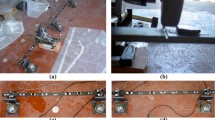Abstract
This paper investigates damage identification techniques based on the difference of modal frequencies, shapes and curvatures in the damaged and undamaged states of the structure. The sensitivity of the identification algorithm with respect to damage parameters is discussed and the minimum number of measured quantities to identify the damage is assessed. It is shown that modal curvatures can be effectively used to pre-localise the damage and to add a penalty term in the objective function which weighs the difference between natural frequencies and modal displacements. Such a term improves the local convexity of the objective function and enhances the convergence rate of the minimization algorithm. The procedure is validated against the results of the experiments on a parabolic arch carried out by the authors. The advantages of such an approach compared to techniques solely based on frequencies are that the ill-conditioning of the inverse problem is reduced and a more accurate estimate of the damage parameters is achieved.













Similar content being viewed by others
References
Farrar CR, Lieven NJ (2007) Damage prognosis: the future of structural health monitoring. Philos Trans R Soc A 365:623–632
Fan YF, Zhou J, Hu ZQ, Zhu T (2007) Study on mechanical response of an old reinforced concrete arch bridge. Struct Control Health Monit 14(6):876–894
Jiang S, Xu F, Fu C (2010) Intelligent damage identification model of an arch bridge based on box-counting dimension and probabilistic neural network. J Comput Inf Syst 6(4):1185–1192
Magalhães F, Cunha A, Caetano E (2012) Vibration based structural health monitoring of an arch bridge: from automated OMA to damage detection. Mech Syst Signal Process 28:212–228
Benedettini F, Capecchi D (1988) A perturbation technique in sensitivity analysis of elastic structures. Meccanica 23(1):5–10
Vestroni F, Capecchi D (2000) Damage detection in beam structures based on frequency measurements. J Eng Mech 126(7):761–768
Montalvao D (2006) A Review of vibration-based structural health monitoring with special emphasis on composite materials. Shock Vib Dig 38(4):295–324
Papadimitriou C, Ntotsios E, Giagopoulos D, Natsiavas S (2012) Variability of updated finite element models and their predictions consistent with vibration measurements. Struct Control Health Monit 19(5):630–654
Nguyen VV, Dackermann U, Li J, Alamdari MM, Mustapha S, Runcie P, Ye L (2015) Damage identification of a concrete arch beam based on frequency response functions and artificial neural networks. Electron J Struct Eng 14(1):75–84
Vestroni F, Pau A (2011) Dynamic characterization and damage identification in dynamic inverse problems: theory and application. In: Gladwell GMR, Morassi A (eds) CISM Courses and Lectures, n. 529, pp 151–178
Cerri MN, Vestroni F (2003) Identification of damage due to open cracks by changes of measured frequencies. In: Proceedings of XVI AIMETA congress of theoretical and applied mechanics, Ferrara
Kim J-T, Ryu Y, Cho H, Stubbs N (2003) Damage identification in beam-type structures: frequency-based method vs mode-shape-based method. Eng Struct 25(1):57–67
Greco A, Pau A (2012) Damage identification in Euler frames. Comput Struct 92–93:328–336
Cerri MN, Ruta GC (2004) Detection of localised damage in plane circular arches by frequency data. J Sound Vib 270(1–2):39–59
Cerri MN, Dilena M, Ruta GC (2008) Vibration and damage detection in undamaged and cracked circular arches: experimental and analytical results. J Sound Vib 314(1–2):83–94
Dessi D, Camerlengo G (2015) Damage identification techniques via modal curvature analysis: overview and comparison. Mech Syst Signal Process 52–53:181–205
Ciambella J, Vestroni F (2015) The use of modal curvatures for damage localization in beam-type structures. J Sound Vib 340:126–137
Pandey AK, Biswas M, Samman MM (1991) Damage detection from changes in curvature mode shapes. J Sound Vib 145(2):321–332
Ciambella J, Vestroni F, Vidoli S (2011) Damage observability, localization and assessment based on eigenfrequencies and eigenvectors curvatures. Smart Struct Syst 8(2):191–204
Chandrashekhar M, Ganguli R (2009) Damage assessment of structures with uncertainty by using mode-shape curvatures and fuzzy logic. J Sound Vib 326(3–5):939–957
Cao M, Radzieński M, Xu W, Ostachowicz W (2014) Identification of multiple damage in beams based on robust curvature mode shapes. Mech Syst Signal Process 46(2):468–480
Dilena M, Morassi A (2011) Dynamic testing of a damaged bridge. Mech Syst Signal Process 25(5):1485–1507
He S, Rose LRF, Wang CH (2013) A numerical study to quantify delamination damage of composite structures using inverse the method. Aust J MultiDiscip Eng 10(2):145–153
Quaranta G, Carboni B, Lacarbonara W (2016) Damage detection by modal curvatures: numerical issues. J Vib Control 22(7):1913–1927 (first published online 2014)
Cao M, Xu W, Ostachowicz W, Su Z (2014) Damage identification for beams in noisy conditions based on Teager energy operator-wavelet transform modal curvature. J Sound Vib 333(6):1543–1553
Cao M, Qiao P (2009) Novel Laplacian scheme and multiresolution modal curvatures for structural damage identification. Mech Syst Signal Process 23(4):1223–1242
Pau A, Greco A, Vestroni F (2011) Numerical and experimental detection of concentrated damage in a parabolic arch by measured frequency variations. J Vib Control 17(4):605–614
Chidamparam P, Leissa AW (1993) Vibrations of planar curved beams, rings and arches. Appl Mech Rev 46(9):467–483
Lestari W, Qiao P, Hanagud S (2007) Curvature mode shape-based damage assessment of carbon/epoxy composite beams. J Intell Mater Syst Struct 18(3):189–208
Unger JF, Teughels A, De Roeck G (2006) System identification and damage detection of a prestressed concrete beam. J Struct Eng 132(11):1691
Abdel Wahab M, De Roeck G (1999) Damage detection in bridges using modal curvatures: application to a real damage scenario. J Sound Vib 226(2):217–235
Ewins DJ (2000) Modal testing, theory, practice, and application, 2nd edn. Research Studies Press, Baldock
Author information
Authors and Affiliations
Corresponding author
Rights and permissions
About this article
Cite this article
Capecchi, D., Ciambella, J., Pau, A. et al. Damage identification in a parabolic arch by means of natural frequencies, modal shapes and curvatures. Meccanica 51, 2847–2859 (2016). https://doi.org/10.1007/s11012-016-0510-3
Received:
Accepted:
Published:
Issue Date:
DOI: https://doi.org/10.1007/s11012-016-0510-3




